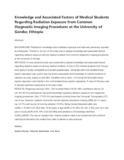Knowledge and Associated Factors of Medical Students Regarding Radiation Exposure from Common Diagnostic Imaging Procedures at the University of Gondar, Ethiopia
Abstract
BACKGROUND: Physicians’ knowledge about radiation exposure and risks was previously reported as inadequate. Therefore, the aim of this study was to assess knowledge and associated factors regarding radiation exposure among medical students from common diagnostic imaging procedures at the University of Gondar.
METHODS: A cross-sectional study was conducted to assess knowledge and associated factors regarding radiation exposure among medical students. A total of 473 medical students (first through sixth years of study) completed a structured questionnaire. Univariate and multi-variable binary logistic regression was used to see the factors associated with knowledge of medical students on radiation sources, exposure and risks. Variables with p-value < 0.2 during the bivariable binary logistic regression were tested in the multivariable binary logistic regression. P-value<0.05 was used to declare significant association at the final model.
RESULTS: Response rate was 100%. Two hundred fifteen (45.5% 95% confidence interval (CI )(41.0%-50.3%)) participants had good knowledge regarding radiation exposure from diagnostic imaging procedures. Only 177(37.4%) participants correctly knew that Computer Tomography (CT) use X-ray. However, subjects incorrectly named magnetic resonance imaging (MRI) as if it used x-ray (12.1%) and source of ionizing radiation (19.5%). Being female [Adjusted-odds-ratio (AOR)=1.57,95% CI(1.05,2.36)], 18-20 years of age [AOR=2.18, 95% CI(1.26, 3.76)], and 1st to 3rd year of study [AOR=3.64, 95% CI(2.23,5.95)] were predictors of knowledge identified.
CONCLUSION: The results highlight that medical students need to be trained well with sufficient radiological education that enable them later to adhere to safe practices.
URI
10.4314/ejhs.v30i4.14https://www.ncbi.nlm.nih.gov/pmc/articles/PMC8054455/
http://ir-library.mmust.ac.ke/123456789/1601
Collections
- Gold Collection [1026]

